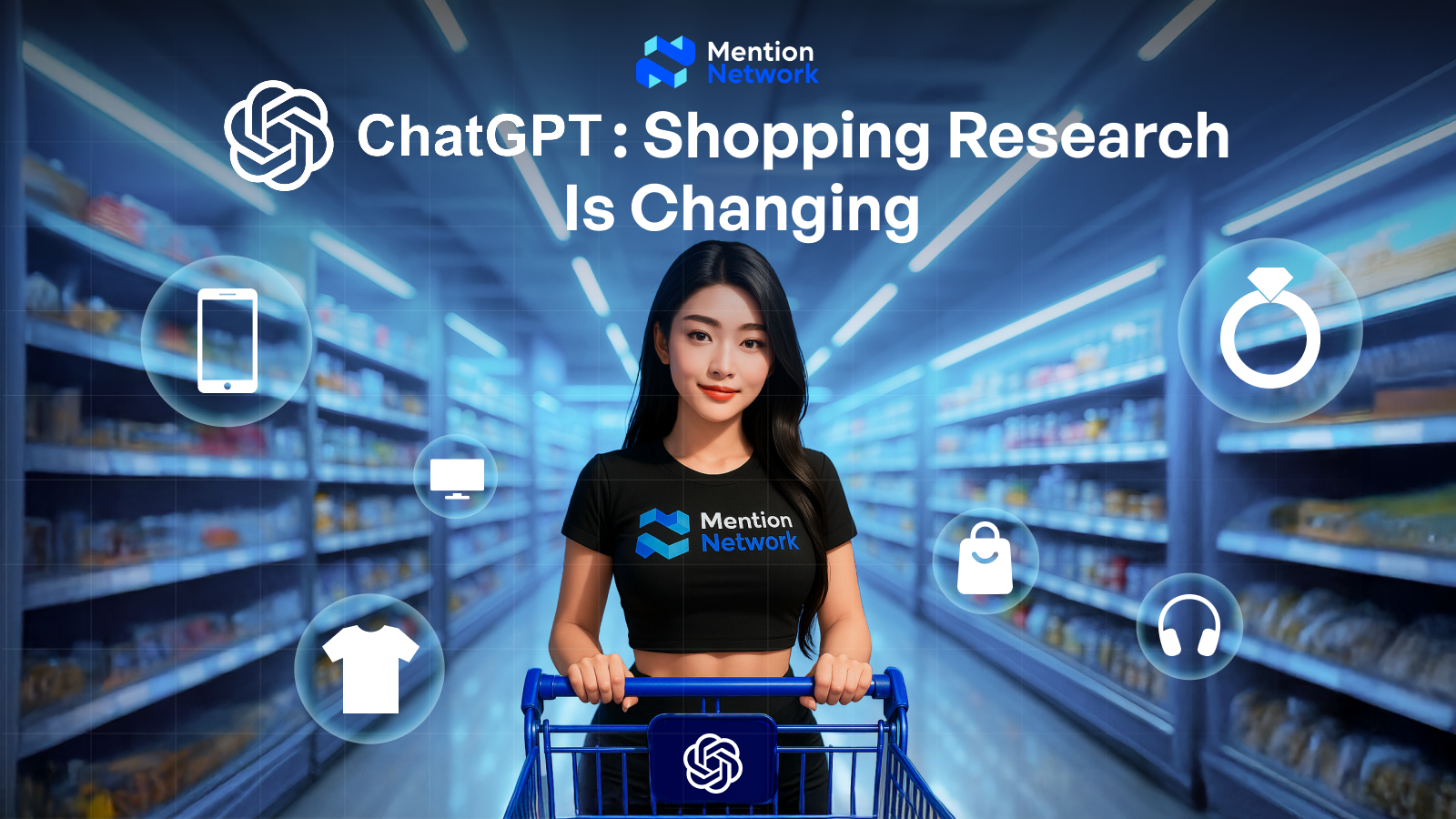How AI Is Rewriting the Consumer Decision Making Process

Online product research used to be simple. Users searched on Google, opened several tabs, compared features, scanned reviews and made a decision. Today that workflow is collapsing into a single step. Consumers increasingly ask ChatGPT or Gemini a detailed question and rely on the synthesized answer as the starting point.
This marks the rise of ChatGPT shopping, where users no longer compare dozens of links but accept curated suggestions shaped by product attributes, constraints and contextual intent. The discovery layer has quietly moved from search pages into AI conversations, reshaping how shopping research unfolds.
Shopping Research Is Migrating Into AI Conversations
When a user asks a complex question like “best running shoes for flat feet under 120 dollars,” they are getting a recommendation, not a list of websites. This turns product research into a zero click experience where the answer becomes the entire journey.
The new flow is shorter and more opinionated. It removes friction and increases the weight of the model’s understanding of the product. This fundamental change creates a new competitive landscape where inclusion inside the model’s shortlist determines AI visibility.
Why Influence Now Happens Inside the Model
Previously, brands competed for rankings on a results page. Now they compete for a place in the model-generated answer. The moment of influence is internal, invisible and entirely dependent on data clarity.
A model recommends your product only if it understands your category, interprets your attributes correctly and trusts your sources. This requires a more technical approach to ChatGPT optimization where precision matters more than volume.
Why Intent Is Deeper Than Traditional Keywords
Conversational AI reads constraints in a way search engines never could. Budget, gender, sizing, material preference and niche use cases all shape the model’s answer.
This means brands must optimize around intent-based context rather than simple keyword matching. Structured descriptions, clear specs and aligned messaging give models the confidence to classify products correctly. This is where refined chat gpt optimization becomes essential for modern shopping research.
What AI Visibility Means for Modern Shopping Research
AI visibility measures how often a brand or product appears inside conversational answers from ChatGPT, Gemini, Claude or Perplexity. It shifts the core question from “Do we rank?” to “Are we present when users ask the model for recommendations?”

This metric is critical because one AI recommendation replaces an entire search results page. If the model picks your competitor, you are invisible at the moment of purchase. Brands must now understand:
- If the model recognizes their product
- How the model describes their attributes
- Which competitors appear alongside them
These three signals shape modern ai visibility strategy.
Why Misinterpretation Leads to Lost Recommendations
LLMs infer meaning from available content. If descriptions are outdated or incomplete, the model misclassifies the product and removes it from the shortlist. In a compressed decision journey, this costs visibility immediately.
To make this easier to grasp, consider the breakdown below:
- Missing specs → wrong category placement
- Repetitive language → loss of nuance
- Weak metadata → no match for contextual queries
- Conflicting content → lower trust inside the model
Understanding these mechanisms is necessary for improving AI visibility inside ChatGPT shopping flows.
How Mention Network Becomes the Visibility Dashboard for Shopping Research
As shopping research moves from search engines to conversational AI, brands need insight into how often AI recommends their products and why. Mention Network converts real user interactions across ChatGPT, Gemini, Claude and Perplexity into clear visibility intelligence. It reveals how models interpret your brand, which attributes they highlight and how you compare to competitors inside AI-generated recommendations.
Detect how often AI models recommend your products
Mention Network shows when and where your brand appears across major LLMs during product-related queries. Because each model behaves differently, these insights help you see where you are strong, where you are missing, and which ecosystems require improved ChatGPT optimization.
Reveal the product attributes AI uses to describe you
AI systems often compress product data, relying on the most available and consistent details. If your descriptions are incomplete or outdated, the model may misinterpret your positioning. Mention Network exposes which attributes AI pulls from your content so you can refine and standardize product pages for better chat gpt optimization.
Understand your competitive position inside AI answers
Models group brands into contextual clusters. Mention Network identifies which competitors appear next to you and which ones AI consistently recommends instead. This helps you understand your AI visibility gaps and see which categories or topics you are losing to rival brands.
Optimize content for AI interpretability
If AI cannot parse your product pages, it cannot recommend you. Mention Network highlights structural issues such as unclear formatting or missing details, helping you adjust product content, comparisons, or FAQs to improve AI retrieval and classification.
Monitor shifts in shopping intent
User intent evolves as LLMs learn. Mention Network tracks which themes, product attributes, and categories rise or decline inside generative answers, helping brands adjust messaging and content to stay relevant within changing AI-driven shopping behavior.
The New AI Shopping Funnel
- In traditional ecommerce, shoppers move through multiple steps: Search → Click links → Read product pages → Compare options → Make a decision.
- With AI-driven ecommerce, that entire journey collapses into a single conversational flow: User intent → AI explanation → AI recommendation → Purchase.

Most of the middle steps disappear because users no longer browse pages. The AI’s answer becomes the new comparison stage, meaning your product is either included or forgotten in a single response.
In this new environment, showing up inside model-generated answers becomes a long-term competitive advantage and missing from those answers means losing the customer instantly.
What Brands Must Do Next
To succeed in this ecosystem, brands should prioritize three core actions:
- Build Structured, High-Clarity Product Content: AI systems interpret clean specs, consistent naming and well-organized details more reliably than unstructured copy. Structure improves understanding and increases recommendation accuracy.
- Create Comparison Content to Teach the Model Category Logic: Models rely heavily on structured comparisons to understand product differences. Clear comparison pages help AI map attributes and category relationships.
- Track and Improve AI Visibility With Mention Network: Measurement is the foundation of improvement. Without understanding today’s presence, brands cannot optimize tomorrow’s outcomes.
Conclusion
Shopping research has moved from search results into conversational AI flows. Users rely on LLMs to compare, evaluate and recommend products, making inclusion inside generated answers critical for discovery.
Brands that understand ChatGPT optimization and actively measure their presence across AI platforms will gain an advantage. Mention Network gives teams clarity, actionable insights and the intelligence required to compete in the next era of shopping discovery.
FAQ
Q1. Why does AI visibility matter for modern shopping?
A1. AI visibility determines whether your product appears inside AI-generated recommendations. As users shift to conversational research, this becomes a direct driver of discovery and consideration.
Q2. How does Mention Network help improve product visibility?
A2. Mention Network tracks product mentions across major AI models, highlighting where you appear, how your attributes are described and where competitors outperform you.
Q3. Do keywords still matter in AI-driven shopping research?
A3. Keywords help with structure, but AI prioritizes semantic clarity and factual consistency. Structured content is more influential than keyword density.
Q4. How often should brands review their AI visibility?
A4. Models update frequently, so brands should monitor visibility continuously. Regular tracking ensures alignment with shifting user intent and evolving model behavior.

